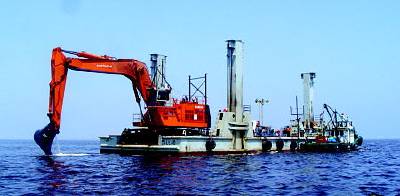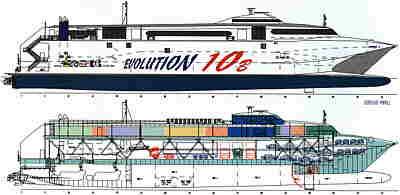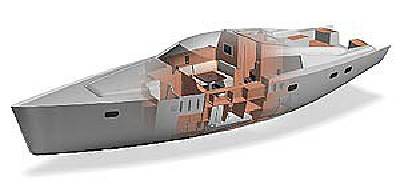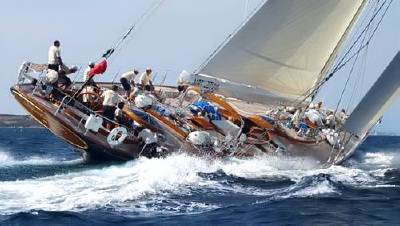Today’s shipyards are under incredible competitive pressures to get it done, get it done right and get it done fast. New CAD/CAM tools help them meet their goals.
Although much work remains to be completed before the ship can be handed over to its new owners, reaching this stage of the construction project has been an incredible journey. Many complex challenges will have been met and issues resolved. Today’s shipyards are under incredible competitive pressures to get it done, get it done right and get it done fast.
They must respond competitively by bringing new, innovative designs to the market, faster, cheaper, and better than ever before. At this year’s Shipbuilding, Machinery and Marine Technology show in Hamburg, Germany, PTC unveiled the next generation of shipbuilding design software that will allow builders to do just that. PTC’s New, Complete Shipbuilding Solution
PTC CAD/CAM software is in use at more than 28,000 companies including such industry leaders as Caterpillar, Lucent, Mitsubishi, Nike and Siemens. PTC is also an emerging leader in collaborative product commerce (CPC) solutions, allowing businesses and people to collaborate in creating, developing, and managing their products over the Web.
 Working with partners like Hyundai Heavy Industries, BAE SYSTEMS, DCN, BIW, and Ingalls, PTC has over 20 years of experience in bringing innovative design solutions to the shipbuilding industry with products like CADDS 5I, Medusa, and Dimension III. These customers are demanding the ability to easily manage design changes, readily access design information, and eliminate hardware/operating system compatibility restrictions. Drawing on its experience with proven solutions and existing customers, PTC recognized that the award winning industry solutions provided by Pro/ENGINEER can be leveraged to develop the next generation shipbuilding solution.
Working with partners like Hyundai Heavy Industries, BAE SYSTEMS, DCN, BIW, and Ingalls, PTC has over 20 years of experience in bringing innovative design solutions to the shipbuilding industry with products like CADDS 5I, Medusa, and Dimension III. These customers are demanding the ability to easily manage design changes, readily access design information, and eliminate hardware/operating system compatibility restrictions. Drawing on its experience with proven solutions and existing customers, PTC recognized that the award winning industry solutions provided by Pro/ENGINEER can be leveraged to develop the next generation shipbuilding solution.
PTC has made a strategic investment in the future and is introducing its next generation shipbuilding platform – Pro/ENGINEER Shipbuilding Solutions. This solution combines the power of Pro/ENGINEER for design with the Web-based collaboration and product design information sharing capabilities of Windchill. Shipbuilders will now be able to control critical design features like decks, frames, bulkheads, and compartments with parameters (i.e. dimensions). Since the geometry has built in relationships, an engineer can readily propagate changes throughout the design. In addition, all downstream deliverables such as manufacturing drawings, machine tool paths, and structural analysis models can be automatically updated to reflect the change because of the inherent “associativity” of the system. Through the information sharing capabilities of Windchill, notification of changes can also be propagated throughout the design staff, eliminating rework and design errors. Associativity can be controlled globally. For instance, an engineer can move a deck and all pipes routed relative to that deck will update. Or locally, if a stiffener changes size, the associated cutouts can be updated. In the extreme case, if once the detail design is begun and a new hull surface is required, the hull could simply be replaced and the structural steel will update to the new shape.
 There are many users of the design information created by the engineer outside of the design staff, and when the information changes, these people need to be informed. With this system, a production engineer could use a Web browser to see the up-to-date mass properties of a manufacturing block as the design evolves and make a crane selection for lifting it, accordingly. Change is unavoidable. Being able to effectively manage it is what enables productivity gains across the shipyard.
There are many users of the design information created by the engineer outside of the design staff, and when the information changes, these people need to be informed. With this system, a production engineer could use a Web browser to see the up-to-date mass properties of a manufacturing block as the design evolves and make a crane selection for lifting it, accordingly. Change is unavoidable. Being able to effectively manage it is what enables productivity gains across the shipyard.
At the core of the Pro/ENGINEER Shipbuilding Solutions is functionality that addresses each of the following disciplines:
- Basic Hull Design
- Structural Hull DesignPiping
- HVAC
- Electrical Systems ·
- Machinery and Structural Outfitting ·
- Routed Systems Support ·
- Accommodations
These modules will allow the user to design in an assembly-centric design environment, creating fully parametric/modifiable 3D structural components. Based on the engineer’s design intent, change propagation can be managed throughout all of the design modules. The routed systems are specification driven and incorporate intuitive routing within the context of the overall 3D assembly. These modules, combined with the existing Pro/ENGINEER simulation (CAE) and manufacturing (CAM) environment tools, provide the user a single, complete design solution.
Widening the Gap with PTC Technology
Engineering is iterative. You know what you want to accomplish but you end up designing over and over again until you come up with a part that fits within your parameters. If your part needs to perform a specific function, bear a specific stress and weigh under a specified amount, you’ll probably need several design iterations before you come up with the solution that meets all the parameters. Behavioral Modeling, a patent-pending technology at the heart of Pro/ENGINEER, is a solution that captures product-intent as a natural part of the engineering process, and then automatically builds virtual prototypes that satisfy these multiple objectives. What’s more, because the problem and solution have been captured electronically in the design, the system can automatically solve future real engineering problems.
In an example that naval engineers can appreciate, the Prada America’s Cup yacht racing team teamed up with PTC and utilized Pro/ENGINEER and its Behavioral Modeling capabilities to create the fastest and most formidable yacht possible – putting Prada on the competitive leading edge of yacht design. Prada team designers were able to run test simulations and render real-life visual scenarios involving the impact of weather and other conditions on the boat’s structural integrity, while optimizing its design for peak performance to the most minute detail.
 PTC is looking to bring improved productivity to the shipbuilding industry in the same way it revolutionized traditional computer aided design in other industries. For example in aerospace, Pro/ENGINEER reduced airframe design by 50%; allowed for 97% first time fit, and 40% reduction in resources on the Global Hawk, Northrop Grumman’s high altitude aerial vehicle. At Lockheed Martin, PTC’s products helped deliver the Atlas rocket program product with a 25% reduction in engineering change orders (ECO’s), saving $10M. These are the proven benefits of this new CAD architecture on complex engineering projects and PTC is bringing these types of positive changes to the shipbuilding industry.
PTC is looking to bring improved productivity to the shipbuilding industry in the same way it revolutionized traditional computer aided design in other industries. For example in aerospace, Pro/ENGINEER reduced airframe design by 50%; allowed for 97% first time fit, and 40% reduction in resources on the Global Hawk, Northrop Grumman’s high altitude aerial vehicle. At Lockheed Martin, PTC’s products helped deliver the Atlas rocket program product with a 25% reduction in engineering change orders (ECO’s), saving $10M. These are the proven benefits of this new CAD architecture on complex engineering projects and PTC is bringing these types of positive changes to the shipbuilding industry.
The shipbuilding industry can employ tools like these to respond to new customer demands and market-driven forces with increased efficiency, even late in the product development cycle. Collaboration is Key to Increased Efficiency, Better End Products
Shipbuilding is becoming increasingly reliant upon collaboration as a means of achieving project goals. Shipyards have shifted toward the extensive use of sub-contractors, increasing the importance of data management and necessitating the sharing of information across an extended enterprise. It is crucial to have a design tool integrated with an enterprise information management system, like PTC’s Windchill, to facilitate this information sharing. This is the idea behind the Pro/ENGINEER Shipbuilding Solutions product.
 With Windchill, the Web is used to link ship information across departments, divisions, strategic suppliers, ship owners, and anyone else who is desired to be included within the extended enterprise. All common product information is stored in shared databases. Data visualization and digital mock-up are accomplished using common web browser technologies. Electronic data from suppliers, which originates from other CAD systems, can be easily retrieved and used for design purposes using PTC’s Associative Topology Bus. Windchill also manages workflow, triggering actions to be taken. In addition, Windchill links existing disparate databases together. For example, a drawing cataloging system could be tied to a bill of material system via simple Web pages. Information can now easily come together to allow engineers to effectively collaborate with other members of the design enterprise. The Complete Shipbuilding Solution
With Windchill, the Web is used to link ship information across departments, divisions, strategic suppliers, ship owners, and anyone else who is desired to be included within the extended enterprise. All common product information is stored in shared databases. Data visualization and digital mock-up are accomplished using common web browser technologies. Electronic data from suppliers, which originates from other CAD systems, can be easily retrieved and used for design purposes using PTC’s Associative Topology Bus. Windchill also manages workflow, triggering actions to be taken. In addition, Windchill links existing disparate databases together. For example, a drawing cataloging system could be tied to a bill of material system via simple Web pages. Information can now easily come together to allow engineers to effectively collaborate with other members of the design enterprise. The Complete Shipbuilding Solution
To be innovative, manufacturers need tools that let them explore design possibilities they might not normally have time to consider. To minimize risk, they need ways to capture and build upon existing engineering knowledge. To be efficient, they need the ability to collaborate throughout the design and manufacturing enterprise. In this global economy, companies must rely on the domain expertise of suppliers and partners who may be located continents away. Keeping everyone connected requires tools to share ideas and tie together information.
In today’s world, collaboration and enterprise integration are essential to allow complex products to be developed effectively and efficiently. This means the geometry world has to be linked to the engineering data management world and information must flow both ways. This leads into what the analysts refer to as collaborative product commerce (CPC). A great strength of PTC is that the company understands both aspects of CPC and has world leading products in both areas. This makes PTC uniquely positioned to provide business solutions for meeting shipbuilding industry challenges.
PTC is proud to present to the shipbuilding industry the next generation of shipbuilding design solutions with the introduction of the Pro/ENGINEER Shipbuilding Solutions package. PTC recognizes the tremendous pressures of competition in the shipbuilding industry and by providing the unique, state-of-the-art collaborative design solution found in Pro/ENGINEER Shipbuilding Solutions, PTC is providing to the shipbuilding community the tools needed to successfully compete in new global markets.








